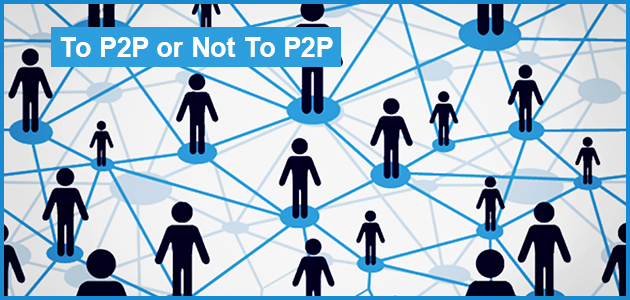
Notorious for being the preferred file sharing method of media pirates, P2P has found redemption in the corporate world. Arrr you likely to benefit from installing P2P software on your company's computers? (We'll see ourselves out.)
Would P2P Make or Break Your Business?
You may know Peer to Peer (P2P) file sharing as the primary method of media pirating, but like bandanas, gold teeth, and other things originally associated with pirates, P2P has infiltrated the mainstream. Indeed, the technology is becoming increasingly popular among businesses seeking a new way to transfer large files. SLICE weighs the pros and cons of P2P so that you can decide whether or not it is a good fit for your business!
How It Operates
Once installed, P2P software enables your computer to directly share digital files with a network of other computers (hence “peer”) running the same or compatible P2P software. Imagine for a moment, that your computer is running Infinit, a P2P app popular among businesses. You would be able make select files available for others on the Infinit network to download and vice versa.
Fair Share?
To P2P or not to P2P? That is the question. There are certainly reasons that support the former stance:
- Pro #1: Cost Effective
- Despite the cloud storage community’s protestations, P2P sharing is cost effective. Because it bypasses the cloud, companies that utilize P2P save money they once spent on storing information in massive servers. P2P file sharing also cuts out the more traditional middleman. An article on IT news website, TechCrunch, tells the story of an Australian video post-production studio that used the aforementioned Infinit to successfully send a 500GB file for free in just over a half an hour. In the past, the studio would have had to hire a delivery service to ship a hard drive.
- Pro #2: Convenient
- P2P will help keep business operations running on schedule! Since P2P software grants you access to an entire network of computers, desired files are usually found very quickly. As staff at that Australian post-production studio can attest, once received, files are downloaded at an incredibly high speed. Better yet, the transfer process can be paused and resumed as needed.
This is not to say that P2P is a flawless file sharing method.
- Con #1: Raises Security Concerns
- In case it is not apparent from our numerous blog posts on the topic, we at SLICE are big on data security. Because we so value data security, we urge you to take security concerns raised by P2P seriously. One such concern is that employees can inadvertently share drives or folders containing sensitive information about their business or its clients with others on the P2P network. If another network user were to download these files, said employee would be unable to retrieve or delete them. Another thing to take into account is that P2P file sharing software often requires you to authorize access to your computer’s firewall, leaving it vulnerable to worms, malware, and other viruses that the firewall would otherwise bar. Granted, they have longevity on their side, but cloud file sharing services have proven much more secure in comparison.
- Con #2: Complicates Collaboration
- In an ironic twist, software that facilitates sharing may actually make divvying up work more difficult. In a P2P file sharing model, users collaborating on a document would have to send the same document back and forth to one another, increasing the likelihood of people losing track of which file is the most recent version, something that can be especially problematic for a business with strict deadlines to meet.
- Con #3: Slows Things Down
- If you and your employees grow impatient when web pages take a long time to load, P2P may be a bad idea. With P2P file sharing, users are concurrently sending requests, downloading, and uploading files. All of this simultaneous activity slows Internet connectivity.
If P2P is 4 U
After weighing all of the pros and cons, you have decided that P2P file sharing is a good fit for your business. Before implementing the practice, it is wise to train employees in P2P to reduce your chances of regretting this decision. Training should demonstrate how to restrict other P2P users’ access to drives and folders and emphasize the importance of minimizing the amount of sensitive information on computers running P2P file sharing programs.
Running a business is a series of decisions. Read our blog and stay informed on all of your options!
